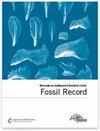First 3D reconstruction of a forewing of a fossil Orthoptera: Interpreting the venation pattern in the smallest known cricket with a stridulatory apparatus, †Picogryllus carentonensis (Orthoptera, Grylloidea, Oecanthidae)
IF 2.1
4区 地球科学
Q3 Earth and Planetary Sciences
引用次数: 1
Abstract
Fossil insects are valuable indicators of the evolutionary history of the clades to which they belong. According to their state of preservation, fossil insects are often partially described for key morphological characters, such as forewing venation in crickets (Orthoptera, Grylloidea). In parallel, the use of 3D microtomography is increasingly becoming common for studying some fossils, which allowed here the precise reconstruction and interpretation of the venation pattern in the smallest known cricket with a stridulatory apparatus, †Picogryllus carentonensis, found in opaque amber. The 3D reconstructions have revealed the general structure of the venation of the forewing and have enabled the identification of all its veins and cells, validating its similarity with that of extant crickets. Putative homologies are established according to previous studies, and some particularities are observed, such as the presence of two crossveins in the mirror, a rare feature in extant crickets that is discussed in the frame of cricket venation evolution. These findings highlight the importance of 3D microtomography as a powerful tool for examining fossil insects and also provide crucial information for taxonomic identification and evolutionary studies, offering a validated morphological basis for future phylogenetic analyses incorporating fossils.首次对直翅目化石前翅进行三维重建:解读已知最小的蟋蟀†Picogryllus carentonensis(直翅目,蝼蛄科,蟋蟀科)的脉纹模式
昆虫化石是昆虫所属支系进化历史的宝贵指标。根据昆虫化石的保存状况,通常会对其关键形态特征进行部分描述,例如蟋蟀(直翅目,蝼蛄科)的前翅脉序。与此同时,三维显微层析技术在研究某些化石方面的应用也越来越普遍,这使得我们能够精确地重建和解释在不透明琥珀中发现的、已知最小的具有褶皱器的蟋蟀†Picogryllus carentonensis的脉络模式。三维重建揭示了前翅脉络的总体结构,并对其所有脉络和细胞进行了鉴定,验证了其与现生蟋蟀脉络的相似性。根据以前的研究,确定了推定的同源性,并观察到了一些特殊性,例如镜面中存在两条横脉,这是现生蟋蟀中罕见的特征,可在蟋蟀脉络进化的框架内进行讨论。这些发现凸显了三维显微层析成像技术的重要性,它是研究昆虫化石的有力工具,也为分类鉴定和进化研究提供了重要信息,为今后结合化石进行系统发育分析提供了有效的形态学依据。
本文章由计算机程序翻译,如有差异,请以英文原文为准。
求助全文
约1分钟内获得全文
求助全文
来源期刊

Fossil Record
PALEONTOLOGY-
CiteScore
2.50
自引率
7.10%
发文量
18
审稿时长
>12 weeks
期刊介绍:
Fossil Record (FR) is the palaeontological journal of the Museum für Naturkunde Berlin. This journal was founded in 1998 under the name Mitteilungen aus dem Museum für Naturkunde Berlin, Geowissenschaftliche Reihe and appears with two issues each year. Fossil Record publishes original papers in all areas of palaeontology including the taxonomy and systematics of fossil organisms, biostratigraphy, palaeoecology, and evolution. All taxonomic groups are treated, including invertebrates, microfossils, plants, and vertebrates.
 求助内容:
求助内容: 应助结果提醒方式:
应助结果提醒方式:


